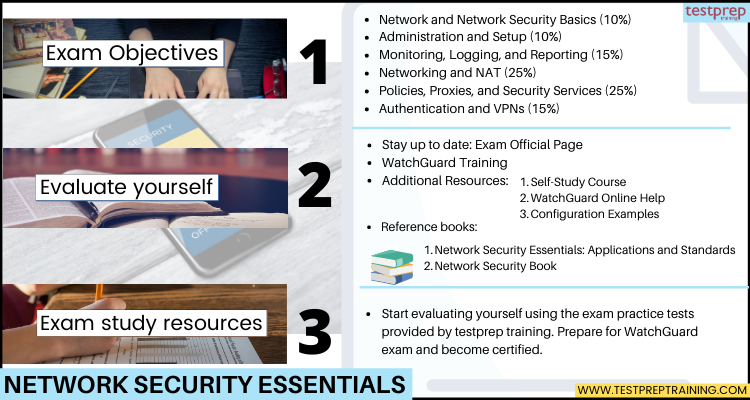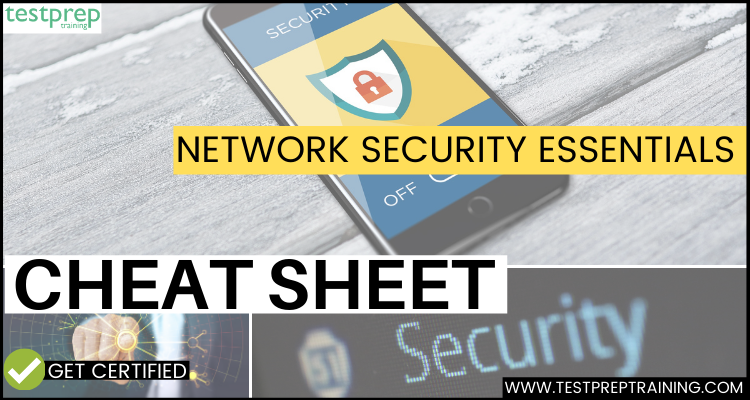The importance of the WatchGuard Network Security Essentials Certification, which is widely regarded as the gold standard of competence, is well known to us. Understand everything you need to know about fundamental networking as well as how to manage, configure, and keep an eye on a WatchGuard Firebox if you want to get the Network Security Essentials certification. In this cheat sheet, we’ll discuss all the paths and places that will lead you to receive this credential in order to assist you to finish everything relevant to the test.
The WatchGuard Network Security Essentials exam tests an individual’s knowledge and understanding of network security concepts, technologies, and WatchGuard’s firewall products. This certification is intended for security professionals, network administrators, and others who are responsible for securing networks. To become certified, individuals must complete a WatchGuard-authorized training course and pass the WatchGuard Network Security Essentials exam.
However, the Network Security Essentials exam is suitable for network administrators who have expertise configuring and succeeding Firebox devices that work Fireware v12.4.
Moving on, below we will talk about the key concepts of Network Security Essentials Cheat.
Network Security Essentials Cheat: Key Concepts
To powerfully complete the WatchGuard Network Security Essentials exam revision, you must get knowledge in these following key concepts:
Fireware Knowledge
- Firstly, Firebox activation and initial setup
- Secondly, Network configuration
- Thirdly, Policy and proxy configuration
- Then, Subscription services configuration
- Next, User authentication
- Device monitoring, logging, and reporting
- Lastly, Branch office and mobile VPN configuration
General Network and Security Knowledge
- Firstly, IPv4 networking concepts (subnets, DNS, TCP/IP, DHCP, NAT, static routing)
- Then, General understanding of firewalls
Test environment
- This is an online proctored exam, with two location testing options: Kryterion testing centre n Online, with virtual proctoring through an approved webcam
Prerequisites for the exam
For this particular exam, there are no prerequisites as such. However, the Network Security video course or instructor-led course is recommended, but not demanded.
Cheat Sheet: Network Security Essentials
We are all aware that WatchGuard offers an unique means of network protection, focusing on delivering best-in-class, enterprise-grade security to any company, regardless of size or technological proficiency. You will be ideal for SMEs and distributed enterprise enterprises if you earn a WatchGuard certification. Nonetheless, having the appropriate resources and a plan of action is crucial for better preparation. So, using this cheat sheet will undoubtedly simplify your preparation process and provide you the assurance you need to ace the test.

1. Getting Familiar with Exam Objectives
Understanding and familiarising yourself with the Network Security Essentials Exam’s primary goals is critical. Knowing the exam objectives will give you a better understanding of the exam. Furthermore, you will be able to better match yourself with the exam’s primary goals. In addition, it aids in the evaluation and marking of areas that may be examined later. However, the topics that are included in the WatchGuard Network Security Essentials certification exam are provided below:
Network and Network Security Basics (10%)
- IPv4 addresses, subnetting and routing (WatchGuard Documentation: Use a 31-bit or 32-bit Subnet Mask, Understanding IPv4 Subnetting (Part 1), IPv4 Subnetting (Part 2))
- The Network Address Translation (WatchGuard Documentation: Network Address Translation (NAT)
- Then, packet headers (TCP, IP, HTTP) (WatchGuard Documentation: HTTP Request: Header Fields, Firebox Configuration Best Practices)
- The MAC addresses (WatchGuard Documentation: Wireless MAC Address of a Trusted Access Point)
- Network services, ports, and protocols (WatchGuard Documentation: About Ports)
Administration and Setup (10%)
- Firebox default policies and network settings (WatchGuard Documentation: Factory-Default Settings, Setup Wizard Default Policies, and Settings, Firebox Configuration Best Practices)
- The Fireware Web Setup Wizard (WatchGuard Documentation: Run the Web Setup Wizard)
- Feature keys (WatchGuard Documentation: About Feature Keys)
- Firebox backup and restore (WatchGuard Documentation: Firebox Backup and Restore)
- Configuration file migration (WatchGuard Documentation: Move a Configuration to a New Firebox, Firebox Upgrade, Downgrade, and Migration)
- Default threat protection (WatchGuard Documentation: About Default Threat Protection)
Monitoring, Logging, and Reporting (15%)
- Tools to monitor Firebox status and activity (WatchGuard Documentation: Monitor your Firebox with Fireware Web UI)
- Diagnostic tools in Firebox System Manager (WatchGuard Documentation: Run Diagnostic Tasks on Your Firebox)
- Firebox logging to Dimension or WatchGuard Cloud (WatchGuard Documentation: Enable Logging for Firebox Cloud)
- Firebox log messages (WatchGuard Documentation: View Log Messages (Dimension), Read a Log Message)
- Logging settings (WatchGuard Documentation: Set Up Logging to a WSM Log Server, Configure Logging Settings)
Networking and NAT (25%)
- Network interface types, security zones, and settings (WatchGuard Documentation: Network Modes and Interfaces, Configure a Custom Interface)
- WINS/DNS (WatchGuard Documentation: Configure Network DNS and WINS Servers, About DNS on the Firebox)
- Routing and static routes (WatchGuard Documentation: Routes and Routing)
- NAT types and configuration (WatchGuard Documentation: Network Address Translation (NAT), Configure Firewall 1-to-1 NAT)
- DHCP (WatchGuard Documentation: Configure an IPv4 DHCP Server)
- VLANs (WatchGuard Documentation: Define a New VLAN)
- Multi-WAN and SD-WAN actions (WatchGuard Documentation: Multi-WAN and SD-WAN)
Policies, Proxies, and Security Services (25%)
- Packet filter policies and proxy policies (WatchGuard Documentation: About Policies)
- Policy precedence (WatchGuard Documentation: About Policy Precedence)
- HTTP proxy (WatchGuard Documentation: About the HTTP-Proxy)
- HTTPS proxy content inspection (WatchGuard Documentation: HTTPS-Proxy: Content Inspection, HTTP Content Action, and Domain Name Rule Examples)
- Content actions and domain name rules (WatchGuard Documentation: HTTPS-Proxy: Domain Name Rules)
- Firmware subscription security services (WatchGuard Documentation: WatchGuard Security Services, About Subscription Services)
Authentication and VPNs (15%)
- Authentication servers (WatchGuard Documentation: Authentication Server Types)
- Users and groups in policies (WatchGuard Documentation: Use Users and Groups in Policies)
- Firebox authentication portal (WatchGuard Documentation: User Authentication Steps, Firewall Authentication)
- Then, Mobile VPN routing options and protocols (WatchGuard Documentation: Select a Mobile VPN Type, Configure VPN Routes)
- Branch Office VPN gateways and tunnel routes (WatchGuard Documentation: Configure Manual Branch Office VPN Tunnel Switching, Add Routes for a Tunnel)
- Branch Office VPN and NAT (WatchGuard Documentation: Configure 1-to-1 NAT Through a Branch Office VPN Tunnel, Configure Outgoing Dynamic NAT)
- The BOVPN virtual interfaces (WatchGuard Documentation: About BOVPN Virtual Interfaces, Configure a BOVPN Virtual Interface)
2. Stay up to date: Using Exam Official Page
Before beginning your preparation for the Network Security Essentials exam, the first thing one must do is to visit the WatchGuard’s official Website. This will help you get updated with the changes and modifications done with the exam. Moreover, there you can also review the WatchGuard Network Security Essentials study guide and topics that you can download the official Blue Print from the WatchGuard’s official website. Exam Updates and changes.
3. Instructor-Led Training
WatchGuard provides this course that offers all the skills you need to gain in order to qualify for the examination. Instructor-led training will help you to get hands-on experience. However, the WatchGuard Network Security Essentials training classes are often held in-region, sponsored by sales or a local WatchGuard distributor. WatchGuard end-users can register for a class in network of WatchGuard Certified Training Partners (WCTPs).
Prepare for the WatchGuard Network Security Essentials Exam using the study guide!
5. Additional Resources
- Self-Study Course (Video)
- WatchGuard offers video-based courseware that you can use for self-study, or to reinforce instructor-led training.
- Online Help
- The Online Help systems provided for the various WatchGuard Fireware management tools include detailed information to expand on the principles presented in the Network Security Essentials training courseware. For the knowledge categories included in the Assessment Objectives section, you can review the corresponding content in the appropriate Help system.
- Configuration Examples
- Fireware configuration examples give you the information you need to configure your Firebox to meet specific business needs. For each example, there is a reference configuration files so you can see the final configuration of the features involved in each use case. This also include a guide to cover the details of each configuration. You can use these configuration examples to help you expand your understanding of Fireware, as it relates to the knowledge categories specified in the Assessment Objectives section.
6. Reference books for good understanding
We highly recommend you to hit the books while you are preparing for the Network Security Essentials exam. Because books provide you a detailed understanding about the exam courses and help you gain deeper insights and profound knowledge. Moreover, you will get familiarity and understanding with concepts and thus work as a good source for any time preparation. For the Network Security Essentials exam guide, the recommended books include:
- Firstly, Network Security Essentials: Applications and Standards by William Stallings
- Secondly, Network Security: Private Communication in a Public World by Chalie Kauffman
7. Evaluate using Practice Tests
Taking a WatchGuard Network Security Essentials sample exam will help you better understand your study method and prepare for the real exam. And, as a result, you’ll be able to discover your weak spots and improve on them. Furthermore, utilizing the WatchGuard Network Security Essentials practice exams can assist you in comprehending the question structure as well as improving your response abilities.
Exam-related terms for better understanding:
Here are some important terms and concepts related to the Network Security Essentials exam:
- Network Security: The practice of protecting computer networks and data from unauthorized access, theft, damage, and disruption.
- Firewall: A network security device that monitors and controls the incoming and outgoing network traffic based on predetermined security rules.
- Intrusion Detection and Prevention Systems (IDPS): A security solution that monitors network traffic for signs of malicious activity and takes actions to prevent it.
- Virtual Private Network (VPN): A secure connection between two networks over the internet, typically used for remote access or site-to-site connections.
- Encryption: The process of converting plaintext data into ciphertext to protect it from unauthorized access.
- Access Control: The process of determining and enforcing who is authorized to access a particular resource or system.
- Authentication: The process of verifying the identity of a user or system to grant access to a particular resource.
- Denial of Service (DoS): A cyber attack that attempts to overwhelm a network or system with a flood of traffic, making it unavailable to users.
- Phishing: A social engineering attack that attempts to trick users into revealing sensitive information, such as usernames, passwords, or financial information.
- Malware: A type of software that is designed to harm a computer network or system, including viruses, worms, and Trojans.
- Incident Response: The process of responding to a security incident, including identifying the cause of the incident, containing the damage, and restoring normal operations.
Things to remember for the exam:
To prepare for the WatchGuard Network Security Essentials exam, you can take the following steps:
- Study the course materials: WatchGuard provides training materials and courses to help individuals prepare for the exam. Enrolling in a WatchGuard-authorized training course is the best way to gain a comprehensive understanding of the topics covered on the exam.
- Gain hands-on experience: It is important to have hands-on experience with WatchGuard firewall products. You can set up a test lab environment or practice using the firewall products in a real-world setting.
- Review exam objectives: Make sure you understand the exam objectives and topics that will be covered on the exam. WatchGuard provides a list of exam objectives on their website.
- Practice with study aids: Use practice exams, flashcards, and other study aids to help you prepare for the exam. This can help you identify areas where you need more study and reinforce your understanding of the material.
- Get rest and arrive early: Make sure you get plenty of rest the night before the exam and arrive at the testing center early. This will help you feel calm and focused during the exam.



